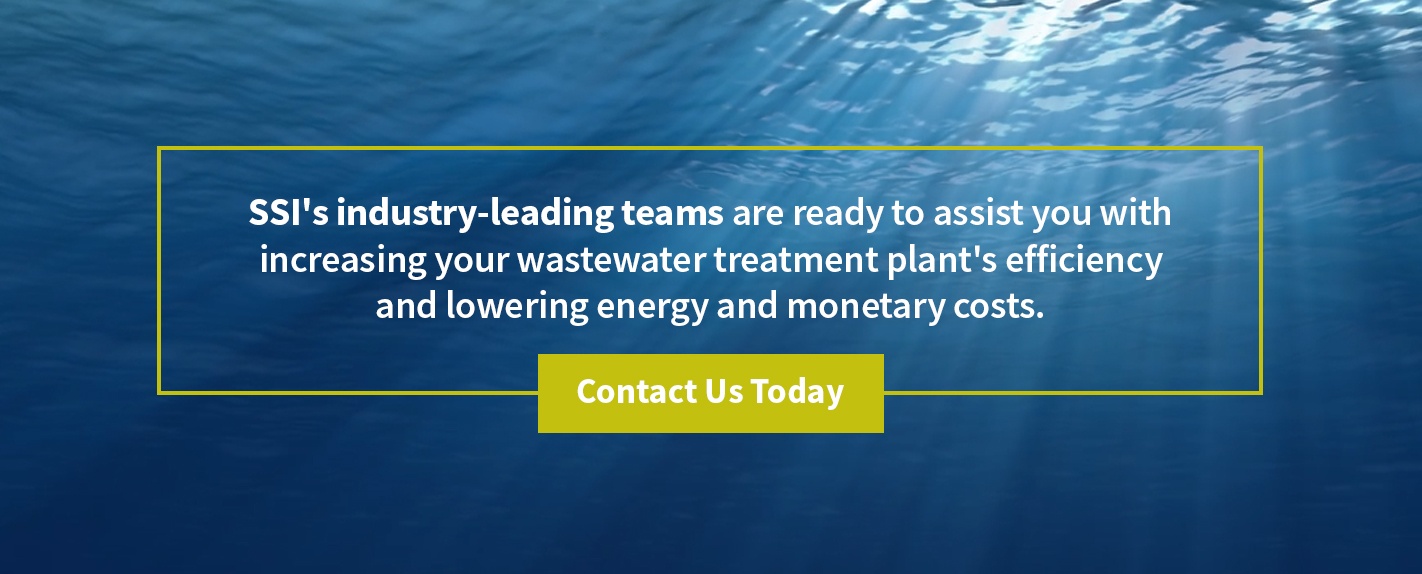How to Reduce the Energy Cost for a Wastewater Aeration System
By: Tom Frankel
Post Date: July 22nd 2019
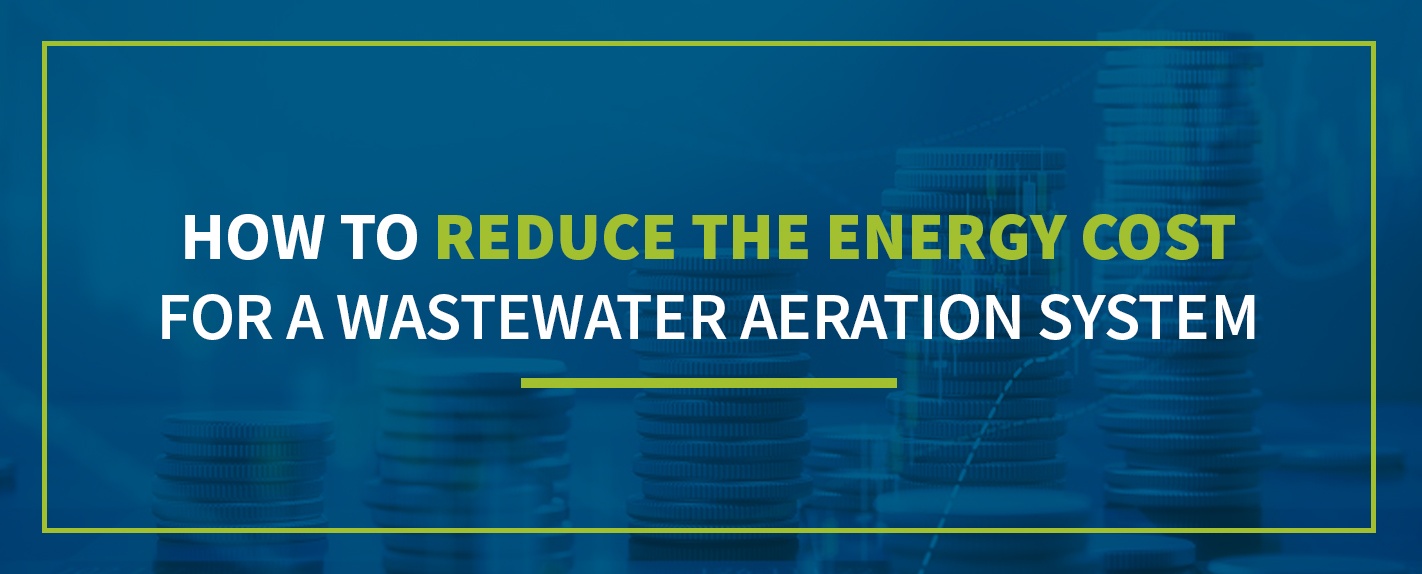
Table Of Contents
- HOW TO REDUCE THE ENERGY COST FOR AN AERATION SYSTEM
- WHY IS AERATION IMPORTANT FOR WASTEWATER TREATMENT?
- HOW TO INCREASE AERATION SYSTEM EFFICIENCY
- CHOOSE THE CORRECT DIFFUSERS
- HOW TO INCREASE DISSOLVED OXYGEN IN WASTEWATER
- WHAT ARE THE TYPES OF WASTEWATER MONITORING SYSTEMS?
- TYPES OF AERATORS IN WASTEWATER TREATMENT
- WHAT IS THE BEST WASTEWATER AERATION SYSTEM?
Most wastewater treatment facilities are enormous, complex operations, treating a million gallons or more a day. All that work translates into high power consumption. The power necessary to run US wastewater treatment plants adds up to 100 billion kWh per year, which is 3% of the annual power usage in the entire United States. This hefty power usage costs $7.5 billion per year.
Wastewater treatment facilities’ energy costs have risen over the past two decades. In 1996, the yearly power expenditure was 75 billion kWh per year, whereas now it comes to 100 billion kWh per year. The increase has occurred for several reasons, including stricter effluent requirements, enhanced removal of certain nutrients, enhanced treatment of biosolids, aging and inefficient wastewater collection systems, and higher electricity rates.
Aeration is one of the primary tools for the treatment of wastewater, especially the secondary treatment phase. Aeration and its electrical systems consume anywhere from 25 to 60% of a plant’s power. The demand can vary widely from plant to plant depending on specific circumstances of the site. In a large plant or one with heavy mixing requirements, banks of blowers of many surface aerators guzzle up many kilowatts per hour of electricity use.
The high monetary and environmental cost of electric power means lowering costs is a priority consideration for designing and operating a diffused aeration system.
How to Reduce the Energy Cost for an Aeration System
The best way to reduce the energy cost for an aeration system is to increase the system’s efficiency.
Plants can increase an aeration system’s efficiency and decrease aeration system costs in several ways. They can change or upgrade the type of equipment they use. They can customize their aeration systems so they calibrate precisely for the plant’s size and treatment goals. They can make use of monitoring systems to gain real-time system information with the click of a mouse and make informed decisions about regular maintenance or address emerging problems.
We will outline some energy-reduction solutions in more detail below.
Why Is Aeration in Wastewater Treatment Important?
In the primary and especially the secondary treatment of wastewater, it is common to use aeration as a method of removing organic matter. Aeration causes oxygen to mix with the wastewater and facilitate the work of aerobic bacteria in breaking down organic waste. Because it is quick and efficient and causes minimal odors, aeration is the preferred technology of today and of the future for wastewater treatment plants.
In an aeration wastewater treatment plant, aerobic microbes use oxygen to break down the organic, carbon-containing waste into carbon dioxide and water. Without oxygen, the waste breaks down much more slowly. It also produces methane and hydrogen sulphide, which give off strong, foul odors.
Plants can use aeration at all points of the wastewater treatment process, from equalization and the grit chamber to post-aeration. It’s most common, though, to use aeration during secondary treatment, especially in the activated sludge process. During the activated sludge process, air pumps into the wastewater tank. After the aerobic bacteria grow and digest the organic material, it settles out, and it is incubated in a settling tank where bacteria continue to do their work. The resulting activated sludge, full of bacteria, then returns to the aeration tank to increase the rate of aeration and make it more efficient.
As a form of wastewater treatment, aeration is economical and quick. It requires an adequate supply of oxygen, the correct distribution of oxygen and sophisticated, durable equipment to maximize mixing capacity and oxygen transfer efficiency (OTE).
How to Increase Aeration System Efficiency
Plants can maximize the efficiency of their aeration systems by using one or a combination of these methods:
Install Fine Bubble Diffusers
Install fine bubble diffusers rather than coarse bubble diffusers or mechanical diffusers. The membranes of fine bubble diffusers contain smaller holes, typically 1 to 3 mm in diameter, and thus a higher density of holes per diffuser. The small bubbles rise more slowly than larger ones, optimizing bubble retention time and allowing for the transfer of more oxygen per volume of air supplied. Many small bubbles also provide much more surface area than a few larger ones. This increased surface area leads to enhanced oxygen transfer as well. Using fine bubble diffusers can reduce energy use by up to 75%, though savings of 30 to 40% are more common.
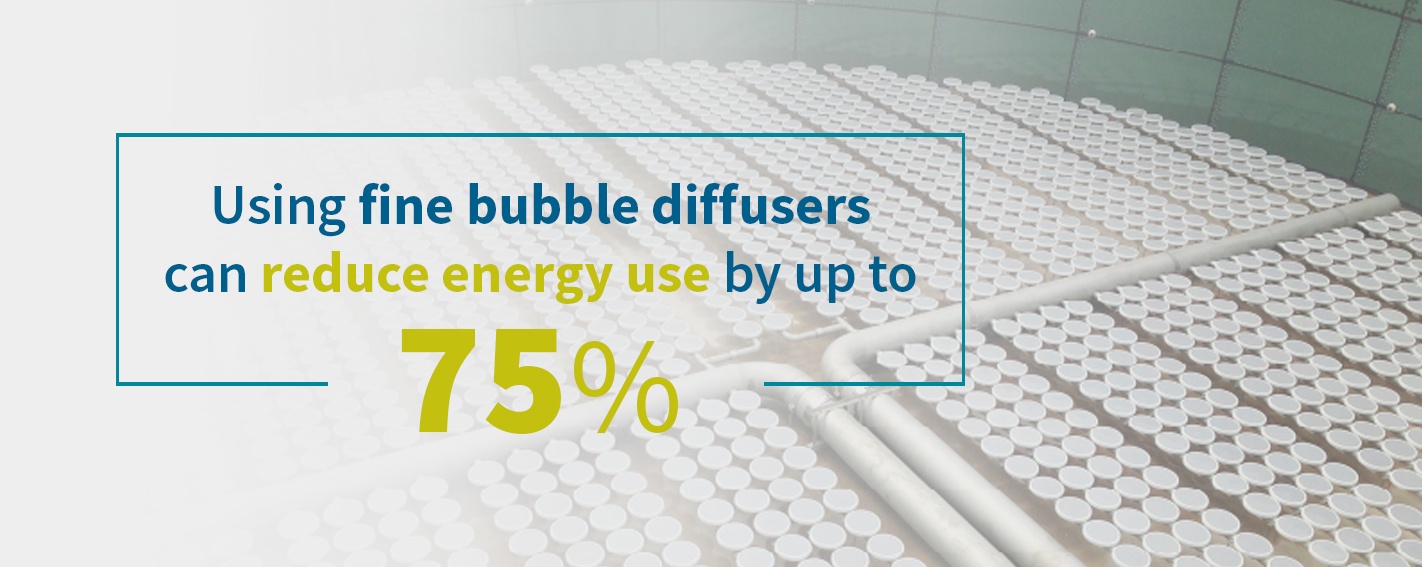
Consider a High Density/Low Flux Aeration System
There are membrane diffusers that are designed to operate at very low airflow rates. The advantage of using this type of aeration system includes very high OTE and uniform distribution of oxygen throughout the tank. The main disadvantage is high capital cost. SSI has worked to reduce the capital cost; take a look at our models ECD215a and ECT70.
Use an Appropriately Sized Aeration System
Proper sizing is important in the design of efficient surface aerators for wastewater treatment. Using more diffusers distributes oxygen more evenly throughout the tank and leads to greater efficiency. Using fewer diffusers leads to reduced efficiency and higher costs.
Operate Correctly Sized Blowers
An aeration system’s blowers must be large enough so the system can operate at full power without damaging the diffusers. Optimally the system should have a minimum 5:1 turndown ratio. To increase turndown, a plant can replace a larger blower with one or more smaller ones, use variable frequency drives (VFDs) or use inlet throttling to alter the airflow of existing blowers. The city of Waukesha, Wisconsin, for example, decreased its energy use by 1,000,000 kWh/year by switching to smaller blowers. The change led to a reduction of 9% in power usage and annual energy cost savings of $65,000.
Choose the Correct Diffusers
The type of material needed will vary with the air pressure, the volume of wastewater, and the composition of the wastewater. Wastewater that contains a high concentration of biosolids or certain chemicals needs hardier diffusers. Some wastewater also requires diffusers with a special coating such as SSI’s PTFE to resist fouling and extend the lifespan of the membranes.
Prevent Fouling
Scrub or pressure-wash diffusers periodically, or clean out flexible diffusers by temporarily increasing the airflow in the system. The temporary increase in airflow removes deposits from pores and helps diffusers continue to be flexible.
Consider Supplementary Oxygen Booster Systems
These inject straight oxygen directly into the water rather than pumping in high volumes of air. Because air is only about 21% oxygen, oxygen booster systems are five times more efficient than standard aeration processes. Use the boosters during high-volume times, for waste with a lot of solids or pollutants in it, or for a slowly increasing load. They help optimize oxygen transfer, have few moving parts and don’t require a lot of maintenance.
Use the Correct Diffuser Configuration
It’s important to distribute oxygen where it will be most effective throughout the water column. One common effective configuration is a tapered configuration that places more diffusers at the mouth of the basin where the organic load is highest and fewer diffusers down the length of the basin where the oxygen demands are lower. The precisely distributed oxygen leads to greater efficiency.
Try Intermittent Aeration
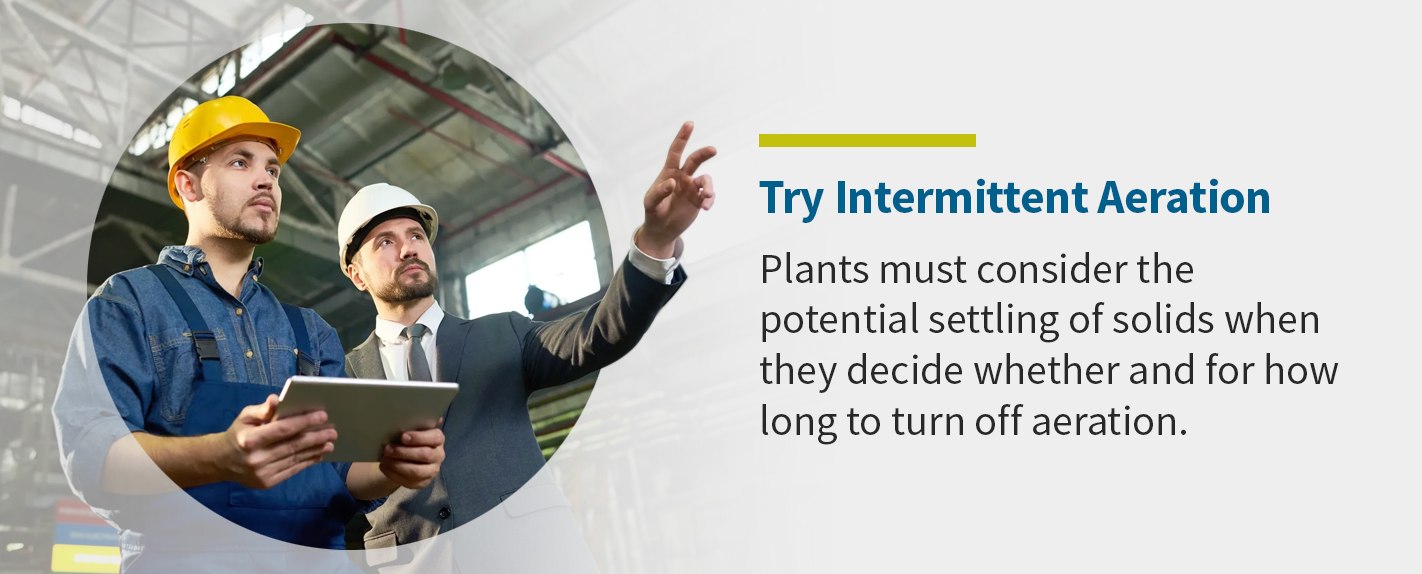
For some facilities, intermittent aeration is a possibility. It saves on energy and costs, though it is not feasible for plants operating near capacity. Plants must consider the potential settling of solids when they decide whether and for how long to turn off aeration. For some facilities, it may be a viable option, though.
Avoid Over-Aeration
Too much aeration increases the dissolved oxygen (DO). Although dissolved oxygen in the wastewater is crucial for effective aeration, DO levels that are close to saturation lower the OTE and contribute to poor sludge settling.
Invest in High-Speed Turbo Blowers
These gearless blowers operate at higher speeds and require less energy than standard blowers. Air bearing turbo blowers create a film of air between shaft and bearings for a nearly friction-free operation. Magnetic bearing turbo blowers contain a shaft that is controlled magnetically to reduce friction. These are both 10 to 20% more efficient than standard blowers.
Use Monitoring Systems
Monitoring systems are vital for keeping an eye on wastewater treatment systems, making sure they function effectively and seeing potential problems before they turn into larger ones. They allow plant managers and staff to do fewer physical inspections, instead of checking on systems electronically. Knowing how to calculate aerator efficiency based on OTE and power output information gained from monitoring systems helps keep the plant running at its highest level.
How to Increase Dissolved Oxygen in Wastewater
To increase DO in wastewater and allow for more efficient aeration, it’s helpful to address the following factors:
- Improve mixing: Though fine bubble aeration is exceptionally efficient and cost-effective, one drawback to fine bubble diffusers is that the smaller bubbles provide less effective mixing than coarse bubble diffusers or mechanical aeration. If powerful mixing and high DO concentrations are a high priority, fine bubble aeration alone may not prove sufficient.
- Use coarse bubble diffusers or mechanical surface aeration: Coarse bubble aeration allows for substantial mixing. The larger bubbles produced by coarse bubble diffusers have more volume, displace more waste liquid and consequently provide more mixing power. Biosolids are kept in suspension and are less likely to form unwanted sludge. The effective mixing of coarse bubble diffusers facilitates the breakdown of organic waste thanks to its powerful combination of oxygen, bacteria and waste material. Surface aerators churn the wastewater for high-powered mixing. These methods can combine with more efficient fine bubble aeration.
- Increase OTR: Increasing oxygen transfer rate (OTR) increases the concentration of dissolved oxygen in the water column. Invest in membranes with PTFE or fEPDM coating to repel sludge and deposit formation, minimize fouling and keep diffusers operating effectively for enhanced oxygen transfer and concentration.
Efficiency Monitoring Systems
Plant managers can monitor the efficiency of their wastewater treatment plants using a few free tools:
- The EPA’s ENERGY STAR portfolio manager: This tool allows users to track energy use and compare it against the energy consumption and efficiency of similar-sized plants. It can help pinpoint problem areas of high energy use.
- MotorMaster+: This system helps manage motors and blowers. Users can manage inventory, log maintenance, track energy use and evaluate efficiency.
- The Department of Energy’s Pump System Assessment Tool (PSAT): This DOE tool helps plant managers determine the efficiency of existing pump systems. It can also assist in figuring out what potential upgrades would provide in terms of energy and cost savings. [EPA 20]
What Are the Types of Wastewater Monitoring Systems?
Wastewater treatment plants can monitor their facility operations using these sophisticated systems:
Telemetry
Telemetry systems involve wireless data transfer via radio or sometimes computer networks. Plant operators can monitor the wastewater treatment plant from anywhere, anytime, as long as they have internet access. They can schedule maintenance, keep an eye on any developments and observe trouble spots before they develop into big problems. Remote telemetry systems monitor temperature, vibrations, humidity, pipe roll-over and pressure. Operators can use cameras to see inside grids and track surface bubble patterns. The user-friendly online dashboard makes it easy to scan for trouble and schedule maintenance.
Supervisory Control and Data Acquisition (SCADA)
SCADA software is a control system architecture that uses computers and network data for high-level monitoring and supervisory operations. Remote terminal units (RTUs) use a telemetry system to allow the physical monitoring systems at the plant to communicate with the computer network. Programmable logic controllers (PLCs) can be set at the plant to control a certain variable, such as airflow. Then operators can use the SCADA system to change those set points. SCADA system uses easy-to-use diagnostic displays to show and record system data and trigger alarms if necessary.
Types of Aerators in Wastewater Treatment
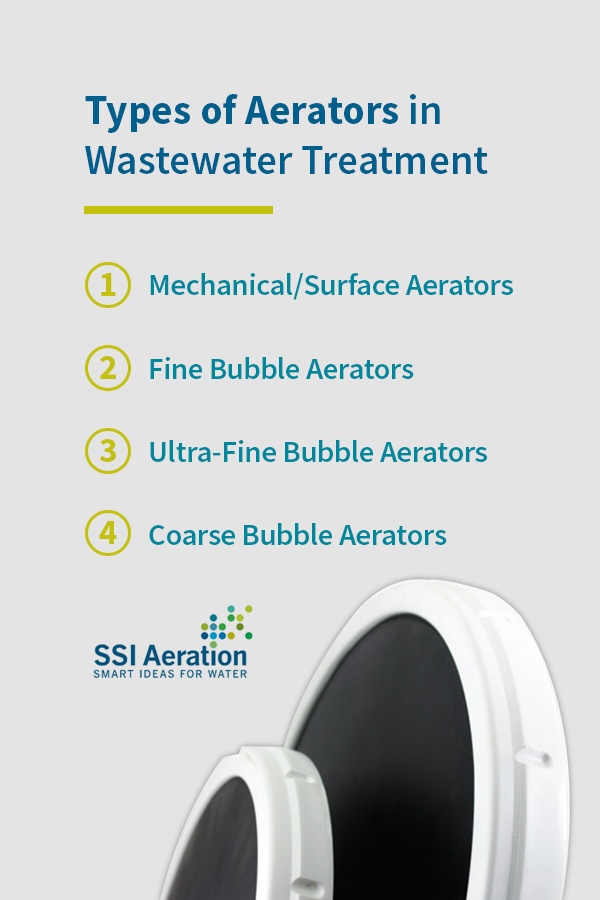
What are the types of wastewater aeration systems? There are a few different aerator options available. Which ones a plant uses will depend on its specific treatment goals.
Mechanical/Surface Aerators
Mechanical surface aerators churn the wastewater and produce sprays of droplets just above the wastewater surface. This churning action creates a large surface area for oxygen to transfer from the air via the liquid droplets. Aeration also occurs as the mechanical equipment draws oxygen into the wastewater. The highest level of dissolved oxygen is closest to the surface and the aerating equipment. Especially in older models, the aeration equipment also does the mixing. These aerators are easier to install over wastewater and can install as a single unit.
They are not well suited for deep tanks since the oxygen churned at the surface cannot reach to the bottom of deep tanks. They also have a lower aeration efficiency. They allow bad-smelling aerosols to form at the top of the liquid, they can get icy in cold temperatures and their rotating mechanical parts require high maintenance.
Fine Bubble Aerators
The benefits of fine bubble aerators include up to twice the efficiency of mechanical aeration, increased mixing capacity over surface aeration, high oxygen transfer, low odor because there is no equipment churning at the surface and low maintenance. They have a higher installment cost than surface aerators because of the complexity of the system, but they incur fewer maintenance costs. Because they are submerged, they will not get icy in cold temperatures. They contribute to a safer work environment because maintenance crews don’t have to work above the water. Fine bubble diffusers come in a range of diameters.
Ultra-Fine Bubble Aerators
These aerators, whose bubbles are typically between .2 and 1 mm, provide premium efficiency. With these models, however, there is concern about the slow speed of bubbles and inadequate mixing.
Coarse Bubble Aerators
The larger bubbles produced by these aerators provide less efficiency than fine bubble aerators. They provide superior mixing, however, and they are more suitable for deep tanks than fine bubble aerators because of their mixing power.
What Is the Best Wastewater Aeration System?
Diffused aeration provides the best efficiency, combining high-quality products with high durability and affordable price points. Technologically advanced product design provides optimum value, and the high durability means the diffusers will keep running like new, providing optimal oxygen transfer. Diffused aeration systems are engineered to support municipal and industrial systems all over the globe.
Encapsulated membranes sealed with state-of-the-art protectants like patented PTFE help the diffuser membranes fouling and last longer. Many plants settle for 5 to 7 years of membrane life, but it’s possible to get 10 years or more. SSI checks each membrane for even perforation depth to ensure uniform bubbles and provides a range of patented coating options such as PTFE coating, antistatic EPDM and PEEK.
Reduce Treatment Plant Energy Costs with SSI Aeration
SSI Aeration offers disc diffusers and tube diffusers for a variety of municipal and industrial uses. Some of the many benefits of using SSI diffusers include the following:
- Cutting-edge technology & quality. These translate into high efficiency, low maintenance costs and a long life, meaning wastewater treatment facilities can meet effluent requirements easily.
- The highest possible oxygen transfer efficiency at a headloss you can live with.
- Piping 38% thicker than competitors’ for maximum durability.
- Quick and simple installation with a saddle, grommet or one-person “Snappy Saddle” mount for an easier work day.
- The option for single-mold design, which allows for a lower price point per diffuser.
- Enough plasticizer to avoid creep but not so much that the plasticizer will leak and cause shrinkage and hardening.
- An experienced drafting and engineering department with 3D, CAD and animation capabilities. Staff members are ready to help plant operators with design, installation and service.
- Moisture purge systems to remove condensation from the piping system. Removing condensation helps ensure even air distribution to all diffusers in the grid.
- The option to install a whole disc diffuser system quickly and easily as one pod.
- Optional pressure-monitoring systems to help determine optimal cleaning times and make maintenance easier.
- Optional acid-dosing systems, which are beneficial for certain types of wastewater systems prone to heavy fouling. They help remove buildup inside membrane pores so the membranes continue to function effectively.
- Optional retrievable aeration systems that plants can install and clean without having to drain the whole tank.
Contact SSI Aeration Today
SSI’s industry-leading teams are ready to assist you with increasing your wastewater treatment plant’s efficiency and lowering energy and monetary costs. Contact us today.

Mr. Frankel co-founded SSI in 1995 with experience in design and distribution of engineered systems. He is in charge of sales, marketing and operations in the company. Mr. Frankel holds multiple US patents related to diffusers. He is a graduate of Washington University in St. Louis.


